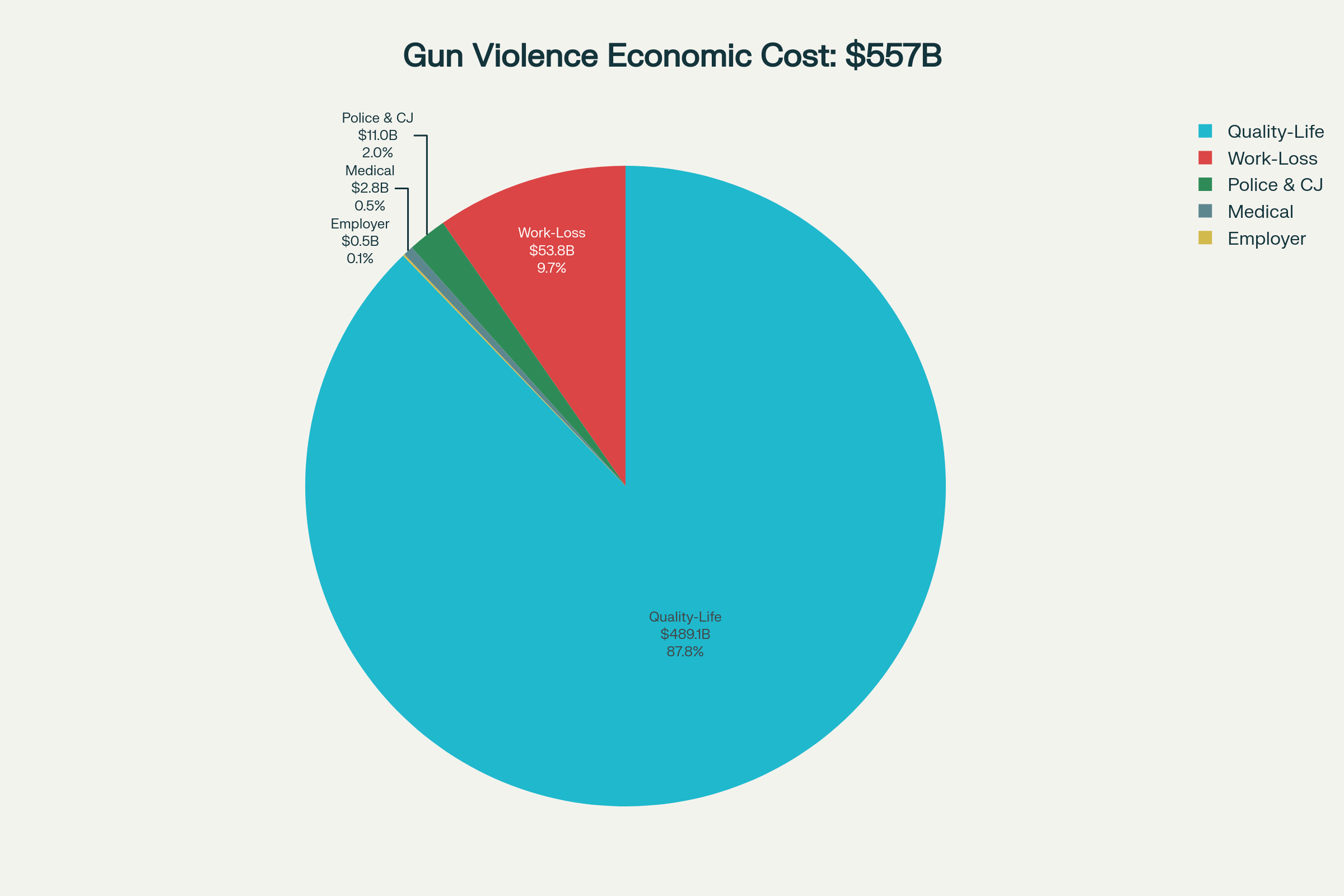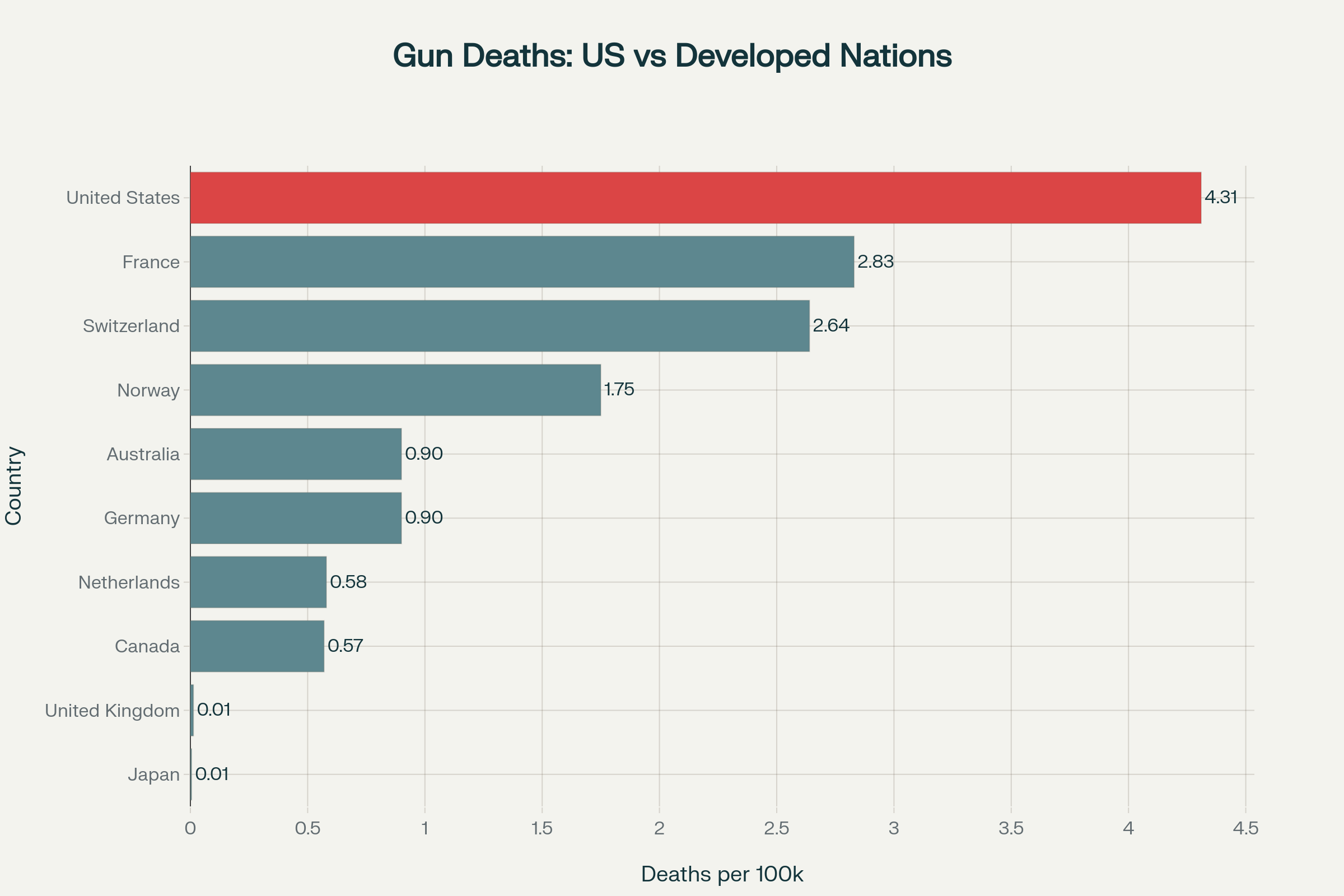America's Gun Culture Crisis: How a Nation Destroys Its Own Citizens Through Violence
Gun violence has become America's most defining and devastating epidemic, transforming the United States into a uniquely dangerous developed nation where firearms claim more lives than anywhere else in the industrialized world. With over 46,000 gun deaths annually and an economic burden exceeding $557 billion, America's destructive gun culture represents a catastrophic failure of public policy, social responsibility, and moral leadership that systematically destroys the lives of its own citizens.1,2,40

The Staggering Human Cost of American Gun Violence
A Daily Massacre Hidden in Plain Sight
The United States experiences a level of gun violence that is virtually incomprehensible to other developed nations. In 2023, firearms killed 46,728 Americans—equivalent to one death every 11 minutes. This represents not just a public health crisis but a fundamental breakdown of society's most basic obligation: protecting its citizens from preventable harm
The statistics paint a picture of systematic carnage that has become normalized in American society. Every day, an average of 327 Americans are shot, with 117 killed and 210 surviving their injuries. Among these daily casualties, 67 die by gun suicide, 46 are murdered, and 90 are shot unintentionally but survive. The sheer scale of this violence dwarfs the casualties of wars, yet it continues with minimal effective intervention.
Mass shootings, while capturing headlines, represent only a fraction of this broader epidemic. In 2024, there were over 488 mass shootings across the United States—almost two per day. However, these highly publicized events account for less than 2% of all gun deaths, obscuring the true scope of everyday gun violence that terrorizes American communities
Children: The Most Vulnerable Victims
Perhaps the most damning indictment of America's gun culture is its impact on children. Since 2020, firearms have become the leading cause of death for children and adolescents in the United States, surpassing motor vehicle accidents. In 2021, gun violence killed 4,752 children, representing a 50% increase from 2019 to 2021. This statistic alone should constitute a national emergency, yet American society continues to tolerate this slaughter of innocents.
The psychological trauma extends far beyond those directly shot. More than 25% of American children witness an act of violence in their homes, schools, or communities annually, with over 5% witnessing actual shootings. These children grow up in a climate of fear, conducting active shooter drills, using bulletproof backpacks, and living with the constant knowledge that they could become victims at any moment.

International Perspective: America's Deadly Exceptionalism
Global Comparisons Reveal American Failure
When examined in international context, America's gun violence rates reveal a level of dysfunction that sets it apart from all other developed nations. The United States has a gun death rate of 4.31 per 100,000 people, which is more than seven times higher than Canada (0.57), about 340 times higher than the United Kingdom (0.013), and 862 times higher than Japan (0.005)
This disparity cannot be explained by cultural or social factors alone, as many countries face similar challenges with mental health, social isolation, and exposure to violent media. The critical difference lies in gun accessibility and the cultural normalization of firearms violence.

Successful Gun Control Models
Other nations have demonstrated that effective gun control can dramatically reduce violence without eliminating legitimate gun ownership. Australia's 1996 National Firearms Agreement, implemented after the Port Arthur massacre, banned automatic and semiautomatic assault rifles, mandated licensing and registration, and instituted a buyback program that removed 650,000 weapons from circulation. The results were remarkable: Australia has not experienced a single mass shooting since, and gun homicide rates dropped by 3% initially, continuing to decline at 5.5% annually through 2013
Japan's strict firearms laws demonstrate how comprehensive regulation can virtually eliminate gun violence. With only shotguns and air rifles permitted for civilian ownership, and requiring extensive background checks, mental health evaluations, and annual inspections, Japan reports fewer than 100 gun deaths annually in a population of 125 million. Most years see fewer than 10 gun homicides nationwide
The United Kingdom's response to the 1996 Dunblane school shooting, which banned handguns and tightened rifle regulations, resulted in gun homicides dropping from over 17.9 deaths per million in 2003 to 9.9 per million in 2021. Firearm offenses plummeted from over 24,000 incidents in 2003 to less than 10,000 in 2021
The Economic Devastation of Gun Violence
A $557 Billion Annual Burden
The economic cost of gun violence extends far beyond immediate medical expenses, creating a massive drain on American resources that could otherwise support education, healthcare, and social development. The total annual cost of $557 billion represents 2.6% of America's entire Gross Domestic Product and is five times larger than the federal Department of Education's budget
This staggering figure breaks down into several categories, with the vast majority—87.8% or $489.1 billion—representing quality-of-life costs from pain and suffering experienced by victims and their families. Work-loss costs account for $53.8 billion annually, reflecting income lost due to death, disability, and incarceration. Police and criminal justice costs consume $11.0 billion, while medical expenses total $2.8 billion.
Regional Disparities Reflect Policy Failures
The economic burden of gun violence varies dramatically between states, directly correlating with the strength of their gun laws. Massachusetts, with comprehensive gun regulations, faces the lowest per-resident cost at $503 annually. In contrast, states with weak gun laws bear much higher costs: Mississippi faces $3,323 per resident annually—more than six times higher than Massachusetts
This disparity demonstrates that stronger gun laws not only save lives but also preserve taxpayer resources for productive investments in education, healthcare, and economic development. States with weaker gun laws effectively subsidize gun violence through higher medical costs, increased police expenditure, and reduced economic productivity.
The Social and Cultural Destruction of Gun Culture
Normalizing Violence and Fear
America's gun culture has fundamentally altered the social fabric, creating a society where violence is normalized and fear permeates daily life. The concept of "social gun culture"—where gun ownership becomes embedded in family traditions, social activities, and community identity—perpetuates this cycle of violence. Research shows that exposure to social gun culture increases the likelihood of gun ownership by 225%
This cultural normalization manifests in disturbing ways: children conducting active shooter drills in elementary schools, families purchasing bulletproof backpacks, and communities investing billions in security measures rather than addressing root causes. The $3 billion spent annually on school security represents resources diverted from education to manage the symptoms of gun violence rather than preventing it
Perpetuating Inequality and Trauma
Gun violence disproportionately affects communities of color and low-income neighborhoods, exacerbating existing inequalities. African Americans, while representing 13% of the population, constitute 55% of gun homicide victims. Black Americans are over 12 times more likely to be murdered by gun violence compared to white Americans
The trauma extends beyond immediate victims to encompass entire communities. The constant threat of violence undermines social cohesion, economic development, and educational achievement. Property values decline in high-violence areas, businesses relocate, and residents live in perpetual fear
Mental Health and the Gun Violence Nexus
The Suicide Epidemic
Gun suicides represent the largest component of America's gun death toll, accounting for 58% of all firearm fatalities. The lethality of firearms transforms impulsive suicidal thoughts into permanent tragedies, with 90% of gun suicide attempts resulting in death compared to less than 3% for other methods.
The availability of firearms in homes increases suicide risk by 300%, particularly among adolescents experiencing mental health crises. States with weaker gun laws have firearm suicide rates twice as high as states with stronger regulations
Beyond Individual Pathology
While gun violence advocates often blame mental illness, research demonstrates that mental health problems alone cannot explain America's exceptional violence rates. Other countries have similar rates of mental illness but dramatically lower gun violence, indicating that access to firearms, not mental health, is the primary differentiating factor
The focus on mental illness also stigmatizes people with psychological disorders, the vast majority of whom are not violent and are actually more likely to be victims than perpetrators. This misdirection prevents implementation of effective gun control measures while unfairly targeting vulnerable populations.
The Failure of American Exceptionalism
A Culture of Rugged Individualism
America's unique gun violence problem stems from the intersection of historical myths about "rugged individualism" and unprecedented access to firearms. This cultural narrative valorizes masculine heroes who impose their will through violence, creating a social environment where gun ownership becomes synonymous with personal autonomy and protection
The concept of American exceptionalism, traditionally used to highlight positive achievements, takes on a darker meaning in the context of gun violence. The United States stands alone among developed nations in its willingness to tolerate routine mass casualty events, particularly those targeting children in schools
Political Paralysis and Special Interests
The National Rifle Association and gun lobby have successfully blocked meaningful reform despite overwhelming public support for common-sense measures like universal background checks and assault weapon restrictions. This political capture represents a fundamental failure of democratic governance, where special interests override public safety and the will of the majority.
The result is a system where gun rights are elevated above the right to life, creating a society where children cannot attend school safely, families cannot gather in public spaces without fear, and communities cannot develop economically due to persistent violence.

Conclusion: The Urgent Need for Transformation
America's gun culture represents a catastrophic social failure... America's gun culture represents a catastrophic social failure that systematically destroys lives, communities, and economic opportunity. With over 46,000 annual deaths, $557 billion in economic costs, and immeasurable trauma affecting millions of families, this crisis demands immediate and comprehensive action
The evidence from other developed nations demonstrates that effective gun control can dramatically reduce violence while preserving legitimate firearms uses. Australia, the United Kingdom, Japan, and other countries have successfully implemented comprehensive reforms that save thousands of lives annually
America faces a choice: continue tolerating this uniquely destructive gun culture that kills its own citizens at unprecedented rates, or join the civilized world by implementing evidence-based policies that prioritize human life over gun rights. The current trajectory is unsustainable, both economically and morally, transforming the United States into a failed state that cannot protect its most basic obligation to its citizens.
The time for half-measures and political excuses has passed. America's gun culture is destroying the nation from within, and only comprehensive reform—including universal background checks, assault weapon bans, mandatory licensing, and cultural transformation—can restore the country's commitment to life, liberty, and the pursuit of happiness for all its citizens.

